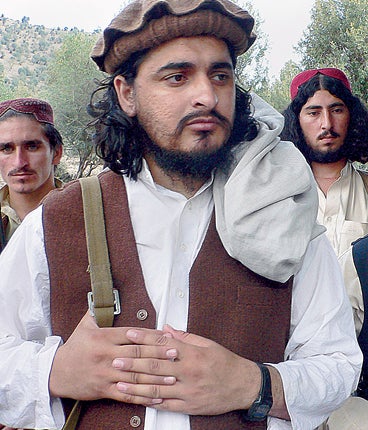Taliban leader was not killed by drone strike, says Pakistan

Your support helps us to tell the story
From reproductive rights to climate change to Big Tech, The Independent is on the ground when the story is developing. Whether it's investigating the financials of Elon Musk's pro-Trump PAC or producing our latest documentary, 'The A Word', which shines a light on the American women fighting for reproductive rights, we know how important it is to parse out the facts from the messaging.
At such a critical moment in US history, we need reporters on the ground. Your donation allows us to keep sending journalists to speak to both sides of the story.
The Independent is trusted by Americans across the entire political spectrum. And unlike many other quality news outlets, we choose not to lock Americans out of our reporting and analysis with paywalls. We believe quality journalism should be available to everyone, paid for by those who can afford it.
Your support makes all the difference.The head of the Pakistan Taliban, whom the US believed it had killed earlier this year in a missile strike fired from an unmanned drone, appears to have emerged from the attack wounded but alive.
Intelligence officials in Pakistan revealed that electronic surveillance and information gathered from sources in the field have led them to believe Hakimullah Mehsud survived the drone strike in January in North Waziristan. His current position in the Taliban is unclear and some reports have said other leaders may have used the attack to exert their influence.
The Taliban had always insisted that Mehsud survived the attack on a mud-walled compound near the village of Pasalkot, although they refused to provide video evidence, saying it would give clues as to his whereabouts.
The Pakistan military were also cautious about claims over his death, even though the country's civilian leadership said it believed Mehsud was dead. It was the US that led the celebrations over the strike, with anonymous government officials telling reporters in Washington that intelligence suggested with "about 90 per cent certainty" that Mehsud had died from wounds sustained in the 14 January attack. They even went as far as to say they believed he had been buried in a plot in Pakistan's tribal areas.
Hakimullah Mehsud had assumed the position of Taliban leader after his namesake and commander, Baitullah Mehsud, was killed in a drone strike last summer. Later that summer, it was claimed the Hakimullah had also been killed – until he contacted journalists to disprove the reports.
Hakimullah's stronghold was in South Waziristan until Pakistani troops launched a major assault on his base there last autumn. He then shifted his camp to North Waziristan, which is where he was attacked in the January strike.
North Waziristan has been the location for many of the missile strikes launched by the US, and Mehsud had found sanctuary in an area controlled by Hafiz Gul Bahadur. The veteran warlord has enjoyed a non-aggression pact with the Pakistan army, although though it has come under strain in recent days as soldiers have been ambushed.
Whether the Pakistan army will now feel pressured to launch new operations in pursuit of Mehsud remains unclear.
The January drone strike against the Taliban leader happened just 72 hours after the release of a video which showed a Jordanian doctor, Human Khalil Abu-Mulal al Balawi, who killed seven CIA agents in Afghanistan last year, sitting with the Taliban leader. It is believed that the Taliban provided at least logistical support to the al-Qa'ida double-agent.
The Associated Press said that one senior intelligence official in Pakistan believed that since the attack in which Mehsud was wounded, his role within the movement has weakened and other senior leaders, such as Waliur Rehman, now overshadow him.
Mehsud's reported survival, first reported by The Guardian, will no doubt be considered something of a set-back by Washington. It also highlights the limitations of the use of drone strikes, a controversial programme which has been greatly expanded since President Obama came to office.
More than 30 strikes have occurred already this year, compared with a reported 49 in 2009. The strikes, which have killed large numbers of ordinary people, are deeply unpopular within Pakistan and have heightened public anger towards the US.
News that Mehsud is thought to be alive, emerged as the leaders of Pakistan and India met yesterday in Bhutan at a regional summit. Prime Ministers Manmohan Singh and Yousuf Raza Gilani had their first substantive talks for nine months.
Indian officials said the talks had been positive and that terrorism and the alleged "slow progress" of Pakistan to investigate those behind the 2008 attacks on Mumbai had been on the agenda.
"The prime ministers ... agreed that co-operation between the two countries is vital for the people of South Asia to realise their destiny," said a senior foreign ministry official, Nirupama Rao.
Pakistan's foreign minister, Shah Mehmood Qureshi, said he would soon be making contact with his Indian counterpart.
Join our commenting forum
Join thought-provoking conversations, follow other Independent readers and see their replies
Comments